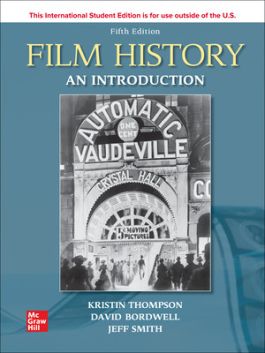Film History: An Introduction ISE
Chapter 1 – The Invention and Early Years of the Cinema, 1180s -1904
Chapter 2 – The International Expansion of the Cinema, 1905 – 1912
Chapter 3 – National Cinemas, Hollywood Classicism, and World War 1, 1913 – 1919
Part Two: The Late Silent Era, 1919-1929
Chapter 4 – France in the 1920s
Chapter 5 – Germany in the 1920s
Chapter 6 – Soviet Cinema in the 1920s
Chapter 7 – The Late Silent Era in Hollywood, 1920-1928
Chapter 8 – International Trends of the 1920s
Part Three: The Development of Sound Cinema, 1926-1945
Chapter 9 – The Introduction of Sound
Chapter 10 – The Hollywood Studio System, 1930-1945
Chapter 11 – Other Studio Systems
Chapter 12 – Cinema and the State: The USSR, Germany, and Italy, 1930-1945
Chapter 13 – France: Poetic Realism, The Popular Front, and the Occupation, 1930-1945
Chapter 14 – Leftist, Documentary, and Experimental Cinemas, 1930-1945
Part Four: The Postwar Era, 1945-1960s
Chapter 15 – American Cinema in the Postwar Era, 1945-1960
Chapter 16 – Postwar European Cinema: Neorealism and its Context, 1945-1959
Chapter 17 – Postwar European Cinema: France, Scandinavia, and Britain, 1945-1959
Chapter 18 – Postwar Cinema Beyond the West, 1945-1959
Chapter 19 – Art Cinema and the Idea of Authorship
Chapter 20 – New Waves and Young Cinemas, 1958-1967
Chapter 21 – Documentary and Experimental Cinema in the Post War Era, 1945-Mid 1960s
Part 5: The Contemporary Cinema Since the 1960s
Chapter 22 – Hollywood’s Fall and Rise, 1960-1980
Chapter 23 – Politically Critical Cinema of the 1960s and 1970s
Chapter 24 – Documentary and Experimental Cinema Since the Late 1960s
Chapter 25 – New Cinemas and New Developments: Europe and the USSR Since the 1970s
Chapter 26 – A Developing World: Continental and Subcontinental Cinemas Since 1970
Chapter 27 – Cinema Rising: Pacific Asia and Oceania Since 1970
Part 6: Cinema in the Age of New Media
Chapter 28 – American Cinema and the Entertainment Economy, the 1980s and After
Chapter 29 – Toward a Global Fil Culture
Chapter 30 – Digital Technology and the Cinema
McGraw-Hill Connect is an award-winning digital teaching and learning solution that empowers students to achieve better outcomes and enables instructors to improve course management efficiency.
High-Quality Course Material
Our trusted solutions are designed to help students actively engage in course content and develop critical higher-level thinking skills while offering you the flexibility to tailor your course to the ways you teach and the ways your students learn.
Assignments & Automatic Grading
Connect features a question bank that you can select from to create homework, practice tests and quizzes. Dramatically reduce the amount of time you spend reviewing homework and grading quizzes, freeing up your valuable time to spend on teaching.
Analytics & Reporting
Monitor progress and improve focus with Connect’s visual and actionable dashboards. Reports are available to empower both instructors and students with real-time performance analytics.
Seamless Integration
Link your Learning Management with Connect for single sign-on and gradebook synchronization, with all-in-one ease for you and your students.


